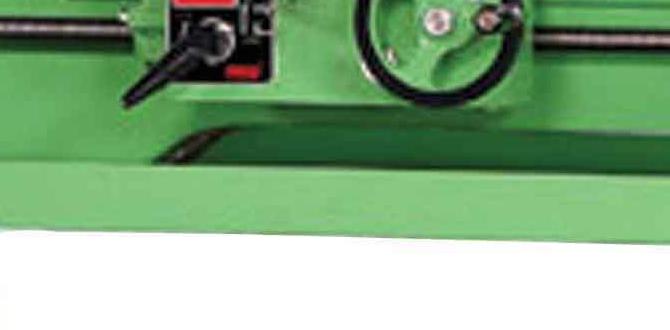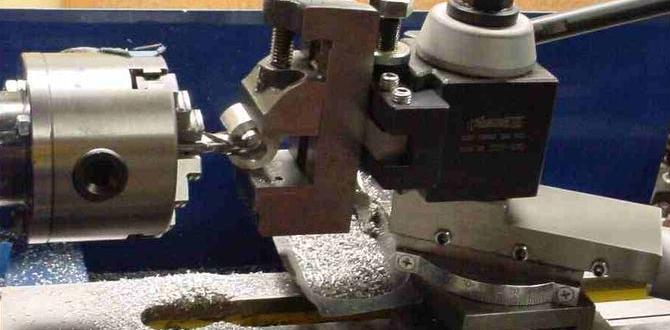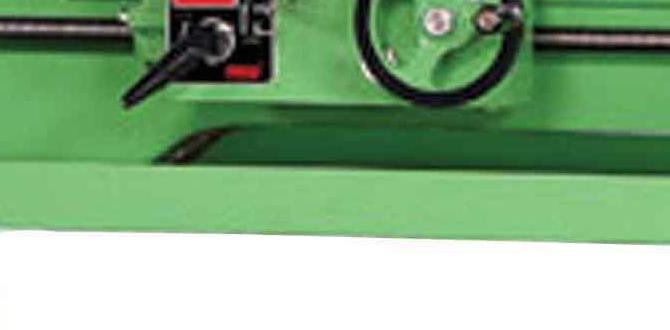This guide reveals how to create your own effective wood lathe sharpening stone, saving money and ensuring your turning tools stay razor-sharp for cleaner cuts and better results. Learn the simple steps to a superior edge.
Ever find yourself wrestling with your wood lathe tools, struggling to get a clean cut? Dull tools can be incredibly frustrating, leading to tear-out, uneven surfaces, and a lot more effort than necessary. It’s a common problem for woodturners, but the solution is simpler – and often cheaper – than you might think. Instead of shelling out big bucks for expensive sharpening stones, why not make your own? It’s a straightforward process that puts a professional-grade sharpening solution right within your reach. Get ready to transform your turning experience with a little DIY ingenuity. We’ll walk through everything you need to know, step-by-step, so you can get back to creating beautiful pieces with ease.
Why a Homemade Wood Lathe Sharpening Stone?
As a woodturner, your tools are your livelihood, or at least your passion. Keeping them sharp is absolutely critical for good work. A dull chisel or gouge doesn’t just make your job harder; it can be dangerous too. A tool that’s not cutting cleanly can suddenly slip, leading to injury. That’s where a good sharpening stone comes in. But high-quality stones can be pricey, and sometimes you need a specific grit size that’s hard to find off the shelf. Making your own sharpening stone gives you control over the abrasive material, the binder, and even the size and shape, all while being cost-effective. It’s a rewarding project that directly impacts the quality of your work and the safety of your workshop.
Think about it: the perfect edge allows your tools to glide through wood, leaving a smooth finish that requires less sanding. This saves you time and effort on every project. Plus, being able to create your own sharpening tools fosters a deeper understanding of your craft and a greater sense of self-sufficiency in your workshop. It’s about more than just saving money; it’s about empowerment and customization.
Understanding Abrasives and Binders
Before we start building, it’s good to know what makes a sharpening stone work. Essentially, it’s two main components: the abrasive material and the binder. The abrasive particles do the actual grinding and sharpening of your tool’s edge. The binder holds these particles together in a solid, durable block. The type and grit of the abrasive determine how aggressive the stone cuts and how fine a finish it leaves. The binder needs to be strong enough to hold the abrasives but porous enough to allow swarf (metal or wood filings) to escape, preventing the stone from glazing over. For woodworking tools, you’ll typically be looking for something that can hold an edge without being overly aggressive, aiming for a balance between speed of sharpening and the quality of the final edge.
Common Abrasive Materials
Several abrasive materials are suitable for creating homemade sharpening stones. The choice depends on the desired grit, durability, and cost.
- Aluminum Oxide (Al₂O₃): One of the most common and versatile abrasives. It’s hard and durable, making it excellent for sharpening steel tools. Available in a wide range of grit sizes, from coarse to very fine.
- Silicon Carbide (SiC): Another very hard and sharp abrasive. It cuts more aggressively than aluminum oxide and is often used for very hard steels or for faster stock removal. It’s also good for sharpening carbide-tipped tools.
- Garnet: Softer than aluminum oxide or silicon carbide, garnet is often used in sandpaper for woodworking. While not ideal for hardened steel lathe tools on its own, it can be incorporated into a blend for a very fine, polished edge on softer woods.
- Diamond: The hardest known material. Diamond abrasives are extremely effective but also very expensive. For a homemade stone, this is usually beyond basic DIY scope unless you can source them inexpensively.
For most wood lathe tools, especially turning gouges and skew chisels, aluminum oxide is an excellent and accessible choice. Silicon carbide can be a good option if you need faster cutting or are sharpening very hard tool steels. You can even experiment with blends of these abrasives to fine-tune the sharpening action.
Binder Options
The binder is what holds the abrasive particles together. It needs to be strong, heat-resistant (as sharpening can generate some heat), and ideally, somewhat porous. Here are some common binder types:
- Resins (Epoxy or Phenolic): These are strong, durable, and can withstand moderate heat. Epoxy resins are widely available and relatively easy to work with. Phenolic resins are often used in manufactured grinding wheels and are very heat-resistant.
- Ceramics: Firing clay with abrasives can create a very durable and porous ceramic stone. This is a more involved process, often requiring a kiln, but results in a high-quality, long-lasting stone.
- Glues (PVA or Hide Glue): While less durable than resins, strong wood glues like PVA (Polyvinyl Acetate) can be used for coarser grit stones or for less demanding applications. Hide glue is traditional but less common for modern sharpening stones.
- Plaster of Paris/Hydrocal: These gypsum-based compounds are easy to mix and cast. They create a porous stone but are less durable than resin-bound stones and can break down with prolonged use or submersion in water.
For a beginner-friendly, durable homemade stone, resin-based binders are generally the best bet. They offer a good balance of strength, ease of use, and cost-effectiveness. Plaster-based binders are a very accessible entry point for experimentation but expect them to wear down faster.
Materials and Tools You’ll Need
Gathering the right materials and tools is the first step to a successful homemade sharpening stone. Don’t worry if some items seem a bit specialized; you might already have some in your workshop, or they can be sourced relatively easily.
Essential Materials:
- Abrasive Grit: Choose your abrasive material (e.g., aluminum oxide or silicon carbide) in the desired grit size. For woodturning, consider a coarser grit (around 120-220) for initial shaping and a finer grit (around 400-800) for honing. You can also get finer grits for polishing. Source these from lapidary suppliers, industrial abrasive suppliers, or even some hardware stores.
- Binder: A two-part epoxy resin is a great choice for durability and ease of use. Look for a slow-cure epoxy for more working time. Alternatively, a Hydrocal or Plaster of Paris can be used for a more experimental, porous stone.
- Mold: This will define the shape and size of your stone. Common options include:
- Wooden blocks with a recess carved out.
- Thick plastic containers (e.g., margarine tubs, plastic food containers).
- Metal boxes.
- Cut sections of PVC pipe.
- Mold Release Agent: To prevent the stone from sticking to the mold. Options include petroleum jelly (Vaseline), commercial mold release spray, or even a thin coating of paste wax.
- Mixing Container: For thoroughly mixing the abrasive and binder. Disposable plastic cups or old plastic food containers work well.
- Stirring Stick: Popsicle sticks or plastic spatulas are ideal for mixing.
- Gloves: To protect your hands from the abrasive and binder. Nitrile gloves are recommended.
- Safety Glasses: Essential for protecting your eyes from dust and splashes.
- Dust Mask: When handling dry abrasive powders.
Tools for Preparation and Finishing:
- Sieve/Sifter: If your abrasive comes in a loose powder, a sieve can help ensure an even distribution.
- Spatula or Scraper: For filling the mold and smoothing the mixture.
- Sandpaper: Various grits (e.g., 120, 220, 400) for smoothing the mold walls or for post-curing finishing of the stone if needed.
- Clamps: To hold mold components together if necessary.
- Optional: A small leveling jig or bench grinder for initial truing of the stone after curing.
Step-by-Step Guide to Making Your Stone
Now let’s get down to business! Follow these steps carefully to create your own effective sharpening stone. Remember, precision in mixing and application will lead to a better final product.
Step 1: Prepare Your Mold
Choose a mold that’s the right size and shape for your needs. A common size for lathe tools might be around 6 inches by 2 inches by 1 inch, but you can adjust this. If using a wooden mold, ensure the interior surfaces (where the stone will form) are smooth. Apply a generous coat of your chosen mold release agent to all interior surfaces of the mold. If you’re using a two-part mold (like a box), make sure it’s sealed well to prevent leaks.
Step 2: Measure and Mix the Abrasive
Determine the volume of your mold. You can do this by filling it with water and then measuring the water, or by calculating based on its dimensions. Once you know the volume, you can estimate how much abrasive grit you’ll need. A common ratio for resin-bound stones is around 50-70% abrasive by volume. For example, if you need 100ml of final stone material, you might use 60ml of abrasive grit and 40ml of mixed epoxy. Measure your abrasive grit accurately. If the grit is very fine, you might want to sift it to remove clumps.
Step 3: Mix the Binder and Abrasive
Follow the manufacturer’s instructions for your epoxy resin carefully. This usually involves mixing two parts (Resin A and Hardener B) in a specific ratio. Mix thoroughly for the recommended time (often 3-5 minutes), scraping the sides and bottom of the mixing container to ensure both parts are fully incorporated. Once the binder is mixed, add your measured abrasive grit. Mix gently but thoroughly until the abrasive is evenly distributed throughout the binder. You want every particle of grit coated. Avoid mixing too vigorously, as this can introduce air bubbles.
If using Plaster of Paris or Hydrocal: Mix the powder with water to a thick, creamy consistency, similar to pancake batter. Do this just before you’re ready to pour, as it sets quickly.
Step 4: Pour into the Mold
Carefully pour the abrasive/binder mixture into your prepared mold. Try to fill it evenly. You can use a spatula or a craft stick to help spread the mixture and fill all the corners. Gently tap the sides of the mold to help any trapped air bubbles rise to the surface. If there are large voids or the mixture seems too dry (with plaster/hydrocal), you may need to adjust your ratios slightly in future attempts.
Step 5: Curing
Allow the mixture to cure completely according to the binder manufacturer’s instructions. For epoxy resins, this can take 24 to 72 hours at room temperature. Depending on the type of epoxy, higher temperatures can sometimes speed up curing, but always check the product data sheet. Plaster of Paris/Hydrocal will set and harden within an hour, but it’s best to let it cure for at least 24 hours before demolding.
Step 6: Demolding and Finishing
Once fully cured, carefully remove the stone from the mold. If you used a mold release agent properly, it should come out cleanly. If it’s stuck, gently pry with a thin blade or loosen the mold if possible. The surface might be a bit rough or uneven. For a resin-bound stone, you might need to do some light sanding with coarse-grit sandpaper to flatten one or both faces and the edges. If you used plaster/hydrocal, it will likely be more fragile, so handle with care. You can wet-sand resin stones with progressively finer grits (e.g., 220, 400, 600) to create a smoother surface if desired, though for sharpening, a moderately rough surface is often preferred.
Sharpening Techniques for Your New Stone
Having a good stone is only half the battle; knowing how to use it effectively is key. For woodturning tools, the goal is usually to achieve a keen, durable edge without removing excessive amounts of metal. This involves consistent angles and smooth, controlled movements.
Achieving the Right Angle
Woodturning tools require different bevel angles depending on their purpose. For example:
- Gouges (Roughing, Spindle, Bowl): Typically 30-45 degrees. Sharpening jigs are highly recommended for consistency.
- Skew Chisels: The bevel angle is crucial for its cutting action, often around 30-40 degrees, but how you present the tool to the stone is more important.
- Scrapers: Often burnished to create a small burr, which is the cutting edge. Sharpening involves grinding the bevel, then creating the burr.
It’s vital to maintain a consistent angle throughout the sharpening process. Using a sharpening jig can significantly help beginners achieve this. Many commercially available jigs are designed for specific types of turning tools and can be adapted for use with homemade stones, provided the stone’s dimensions fit the jig.
Sharpening vs. Honing
It’s important to distinguish between sharpening and honing. Sharpening involves removing metal to re-establish a bevel and an edge. Honing is a lighter process to refine and polish that edge, often by removing a microscopic burr or very fine wire edge.
Your homemade stone can serve both purposes. If you made a coarser grit stone (e.g., 220 grit), it’s great for reshaping a dull or damaged edge. If you made a finer grit stone (e.g., 600-800 grit, or even finer if you experimented), it’s excellent for honing and refining the edge after rougher sharpening, or for regular touch-ups.
Using Your Stone Effectively
- Wet or Dry? Many sharpening stones perform best when used with a lubricant. For oil stones, you use honing oil. For water stones, you use water. Resin-bound stones can often be used dry, but a light spritz of water can help keep the surface clean and reduce dust. Plaster/hydrocal stones are typically used wet. Experiment to see what works best for your stone and your tools.
- Consistent Motion: Move the tool edge across the stone in a smooth, sweeping motion, maintaining your chosen bevel angle. For gouges, this usually means sweeping the bevel across the stone. For skews, it’s about presenting the correct part of the bevel at the correct angle.
- Work Both Sides: For chisels and skews, sharpen one side of the bevel, then flip the tool to sharpen the other side, if applicable to the tool geometry. For gouges, the back hollow-grind is often refined on the stone.
- Check for the Burr: As you sharpen, a tiny wire edge or “burr” will form on the opposite side of the edge you are grinding. You can often feel this burr by gently (and carefully!) running your fingertip across the edge from the spine towards the cutting edge. Once you feel a burr along the entire length of the edge, you know you’ve ground through.
- Honing and Deburring: After grinding on the coarser grit, switch to your finer grit stone. Use the same technique but with lighter pressure to refine the edge and remove the burr. A few light passes are usually sufficient. A leather strop, often with a polishing compound, is the final step for many turners to achieve a mirror polish and remove any remaining microscopic burr.
Regularly cleaning your stone is also important. If it glazes over (gets shiny and stops cutting), you may need to lightly scrub it with a stiff brush and water, or even flatten it slightly on a coarser grit surface.
Pros and Cons of Homemade Sharpening Stones
Like any DIY project, making your own sharpening stone has advantages and disadvantages. Weighing these will help you decide if it’s the right path for your workshop.
Advantages:
- Cost Savings: Significantly cheaper than many commercially produced stones, especially custom or high-grit options.
- Customization: You can create stones of specific sizes, shapes, and grit combinations tailored to your tools and preferences.
- Learning Experience: Building your own tools provides valuable insights into their construction and function, enhancing your overall understanding.
- Material Control: You can choose the abrasive and binder that best suit your needs, potentially sourcing higher-quality abrasives than found in some cheaper manufactured stones.
- Accessibility: Uses readily available materials, making it a project accessible to most home workshop users.
Disadvantages:
- Durability: Homemade stones, especially those made with plaster or weaker binders, may not be as durable or long-lasting as professionally manufactured stones.
- Consistency: Achieving a perfectly uniform distribution of abrasive and a perfectly flat surface can be challenging, leading to inconsistent sharpening performance initially.
- Time Investment: Requires time for preparation, mixing, curing, and finishing.
- Performance Variation: The sharpening action







